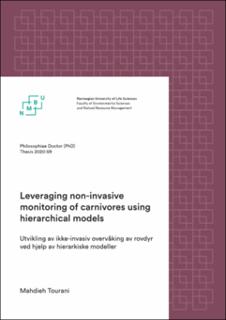| dc.contributor.advisor | Bischof, Richard | |
| dc.contributor.advisor | Gimenez, Olivier | |
| dc.contributor.advisor | Nawaz, Muhammad Ali | |
| dc.contributor.author | Tourani, Mahdieh | |
| dc.date.accessioned | 2023-02-23T12:55:59Z | |
| dc.date.available | 2023-02-23T12:55:59Z | |
| dc.date.issued | 2020 | |
| dc.identifier.isbn | 978-82-575-1726-7 | |
| dc.identifier.issn | 1894-6402 | |
| dc.identifier.uri | https://hdl.handle.net/11250/3053623 | |
| dc.description.abstract | The development of non-invasive approaches for monitoring wildlife populations made it feasible to obtain ecological parameters across landscapes and populations, rather than a few locations or individuals. The two most popular and widespread non-invasive monitoring methods are camera trapping and genetic sampling. The technical development associated with data collection has been impressive, whilst analytical capabilities have lagged behind. Only recently are we getting close to exploiting the potentials of non-invasively obtained data. The objective of my thesis is to apply modern hierarchical analytical models to several sets of carnivore monitoring data to address a series of conceptually and methodologically connected problems, faced by applied ecologists.
The thesis consists of four articles. Two of these include simulations, and all four articles involve model fitting and case studies. The latter target a range of species including wolverine and mesocarnivores in Scandinavia and the Himalayan brown bear.
Article I quantifies detectability of mesocarnivores by camera traps and sheds light on the behavioural responses of focal species to detection devices and to olfactory lures as an important aspect of detectability. Article II incorporates multiple data sources with varying levels of information in a data-sparse situation and introduces a multiple observation process model in the spatial capture-recapture framework to estimate population parameters. This model is applied to multi-method monitoring data of a Himalayan brown bear population in Pakistan. The focus in Article III is heterogeneity in the environment and it uncovers sex-specific patterns in wolverine home range size across the species’ range in Norway using solely non-invasively collected DNA data and spatial capture-recapture models. Article IV presents and evaluates an extension of the open-population spatial capture-recapture model to improve inferences on population parameters and showcases its application on wolverine data in central Norway.
Hierarchical modelling offers ecologists an intuitive multi-level approach to disentangle observation and ecological processes. All chapters of this thesis include hierarchical models that account for imperfect detection. Depending on the research question, I use these models to estimate time-to-detection of species, population abundance and density, survival, variation in home range size and inter-annual movement. The monitoring methods used during this thesis are often applied to studies of rare or elusive species and data sparsity is another important challenge addressed in this thesis. Bayesian inference Using Gibbs Sampling (BUGS) language facilitates the construction of flexible models that make the incorporation of multiple types of data into one comprehensive analysis comparatively straightforward. The articles included in this thesis showcase how hierarchical models help us use non-invasively collected data to yield answers to a range of questions in applied ecology. Tackling the associated challenges increases our ability to draw inferences that more closely describe the complexity of real-world ecological systems. | en_US |
| dc.description.abstract | Utviklingen av ikke-invasive metoder for å overvåke dyrepopulasjoner har gjort det mulig å estimere økologiske parametere på tvers av landskap og populasjoner, snarere enn noen få steder eller individer. De to mest populære og utbredte ikkeinvasive overvåkingsmetodene er viltkameraer og genetisk prøvetaking. Den tekniske utviklingen knyttet til datainnsamling har vært imponerende, mens analytiske evner har hengt etter. Først nylig har vi kommet i nærheten av å utnytte potensialet til ikke-invasivt innsamlede data. Målet med avhandlingen min er å bruke moderne hierarkiske analytiske modeller på flere sett med overvåkningsdata av rovdyr for å adressere en serie konseptuelt og metodisk koblede problemer, som anvendte økologer møter.
Oppgaven består av fire artikler. To av disse inkluderer simuleringer, og alle de fire artiklene involverer modelltilpassing og case-studier på en rekke arter, inkludert jerv og mesokarnivorer i Skandinavia og Himalaya brunbjørn. | en_US |
| dc.language.iso | eng | en_US |
| dc.publisher | Norwegian University of Life Sciences, Ås | en_US |
| dc.relation.ispartofseries | PhD thesis;2020:59 | |
| dc.rights | Navngivelse-Ikkekommersiell-DelPåSammeVilkår 4.0 Internasjonal | * |
| dc.rights.uri | http://creativecommons.org/licenses/by-nc-sa/4.0/deed.no | * |
| dc.subject | Applied ecology | en_US |
| dc.subject | Quantitative ecology | en_US |
| dc.subject | Hierarchical modelling | en_US |
| dc.subject | Non-invasive monitoring | en_US |
| dc.subject | Spatial capture-recapture | en_US |
| dc.subject | Density estimation | en_US |
| dc.subject | Occupancy models | en_US |
| dc.subject | Carnivore | en_US |
| dc.subject | Camera trap | en_US |
| dc.subject | Non-invasive genetic sampling | en_US |
| dc.subject | Spatial ecology | en_US |
| dc.subject | Wildlife management | en_US |
| dc.subject | Scandinavia | en_US |
| dc.title | Leveraging non-invasive monitoring of carnivores using hierarchical models | en_US |
| dc.title.alternative | Utvikling av ikke-invasiv overvåking av rovdyr ved hjelp av hierarkiske modeller | en_US |
| dc.type | Doctoral thesis | en_US |
| dc.description.version | publishedVersion | en_US |
| dc.subject.nsi | VDP::Mathematics and natural science: 400 | en_US |

